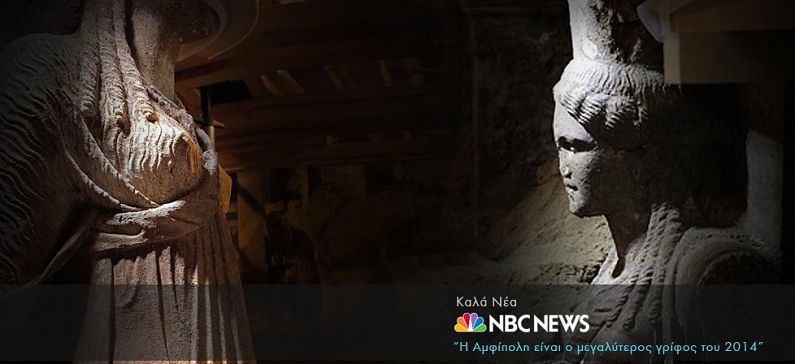
NBC: Amphipolis the biggest riddle of 2014
Amphipolis is the biggest riddle for 2014 according to NBC News. NBC presents 10 cases from the past year in which scientists answered old riddles, faced up to life-and-death riddles, or found new riddles.
Number one on the list is the Amphipolis case and the unanswered question «who’s buried in a 2,300-year-old tomb in Greece?». Ofcourse cases like contolling fusion power, ebola cure are included in the list.
1. Amphipolis tomb unearthed: Archaeologists discovered a previously unknown tomb in northern Greece that they dated to Alexander the Great’s era in 300 B.C. So far they’ve found intriguing mosaics, statues of maidens and sphinxes — and a skeleton. Who was buried there? We should get a better idea in 2015.
2. Bird evolution traced using DNA: After years of analysis, researchers laid out a huge array of studies detailing how thousands of bird species arose just after the dinosaurs departed the scene. The DNA analysis also has implications for human brain function and potential climate effects on the world’s birds.
3. California drought and the East’s Big Chill: The crazy weather patterns that left California drywhile blasting the eastern U.S. with wintry weather pose meteorological riddles, and challenges for those who have to deal with droughts and storms. Was this year’s wild weather a portent of things to come?
4. Climate realities take hold: A series of studies — including the latest global assessment from a U.N. panel as well as a White House assessment on the national level — laid out the dismal effects that are expected from climate shifts. 2014 is shaping up as one of the warmest years ever recorded.
5. DNA alphabet gets more letters: The genetic code in our DNA is built up using four chemical «letters» — adenine, thymine, guanine and cytosine (A, T, G and C) — but this year, scientistsadded two more letters (X and Y) to the alphabet in a genetically modified bacterium. Now the researchers who pulled off the trick are trying to get the «semi-synthetic organisms» to producecustom-engineered proteins.
7. First Americans” secrets come to light: Genetics and anthropology came together to shed new light on the peopling of the Americas, from the roots of the ancient migration in now-vanished Beringia, to the connections between the ancient Clovis people and today’s Native American tribes, to the «game-changing» underwater discoveries made in a Mexican cave.
8. Fusion quest hits a milestone: Researchers at the National Ignition Facility said they produced a laser fusion reaction that released more energy from its fuel than the energy that was put into the fuel. It’s not anywhere near the long-hoped-for break-even point for controlled fusion, because a lot of energy was lost along the way. Nevertheless, it’s progress. Other fusion researchers are working on still other strategies.
9. Genetics of Neanderthals and humans: It’s been four years since the Neanderthal genome was first sequenced, but this year’s advances fleshed out the story of how ancient hominids diverged into different species. Among the highlights were insights into what we inherited (and didn’t inherit) from Neanderthals, the time frame for human-Neanderthal interbreeding, and the process by which the two populations diverged. We learned more about our Denisovan heritage as well.
10. Spinosaurus straddles land and water: A detailed study of Spinosaurus fossil bones revealed that this particular dinosaur was an odd duck, in more ways than one. The new view of the creature’s skeletal structure suggests strongly that it spent a lot of its time swimming in the water — and that when it walked on land, it waddled like a duck. The Spinosaurus project was also notable for its use of 3-D scanning and 3-D printing to produce models of the fearsome but ducky dinosaur.







